|
|

|
Porsche, and the Porsche crest are registered trademarks of Dr. Ing. h.c. F. Porsche AG.
This site is not affiliated with Porsche in any way. Its only purpose is to provide an online forum for car enthusiasts. All other trademarks are property of their respective owners. |
|
|
| L-Jet914 |
 Feb 25 2025, 11:35 PM Feb 25 2025, 11:35 PM
Post
#1
|
|
Member   Group: Members Posts: 365 Joined: 24-October 12 From: Davis, CA Member No.: 15,080 Region Association: Northern California |
I was installing my new ignition and FI harnesses today and I decided to look back at the vacuum hose routing diagram on Jeff Bowlsby's website. I knew my vacuum hose routing had been modified by whatever technician worked on my father's 74 914 1.8 years ago. I noticed that they teed the vacuum retard side of the vacuum advance into ported vacuum off of the intake plenum. According to the vacuum routing hose diagram, it's supposed to be connected to the rear port of the throttle body (which only gets vacuum after the throttle plate moves off idle). Would there be any reason the technician did this? I will end up rerouting the vacuum hose to the proper location. I'm just curious as to why it was modified for whatever reason. So would my 74 1.8 be considered a early or late 1.8? According to the late diagram and the throttle body that is in the car, the hose should route to the front port instead of the rear port.
The part number on the throttle body in the car 022133067C which fits either a Super Beetle 75-79, 76-83 Bus, or 83-84 Vanagon (two port t-body). According to the PET on AA's website shows two different throttle bodies 022133062L or 022133062S for California spec 1.8L 914s. The Porsche PET does not list a throttle body part number for the 1.8, only the 1.7 and 2.0s. Curious as to why someone would put the wrong part number throttle body on my 914, though it does have the 3 pin throttle position sensor. Port setup would be indicative of late 74 because the required port (front of throttle body pointing toward front of vehicle) is behind the throttle plate. Attached thumbnail(s) 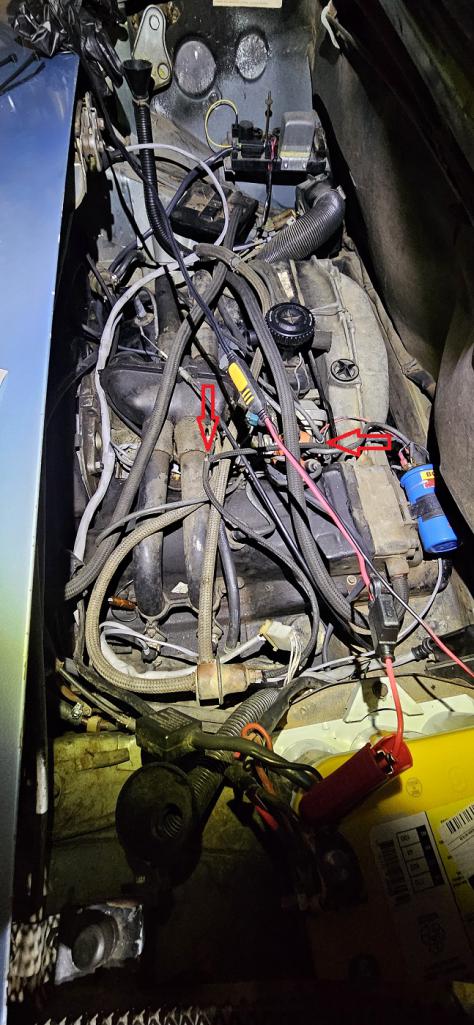 Attached image(s) 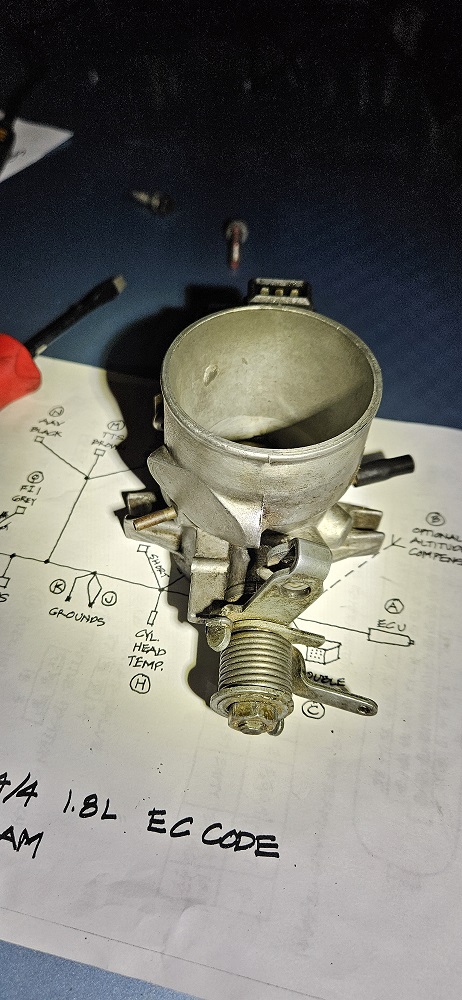 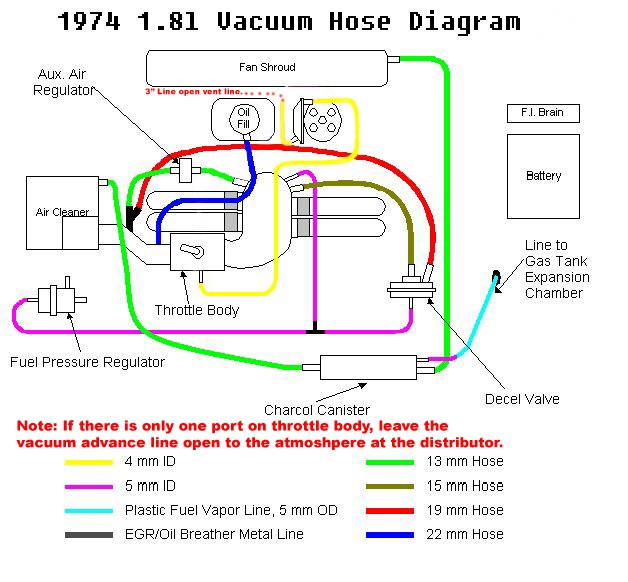 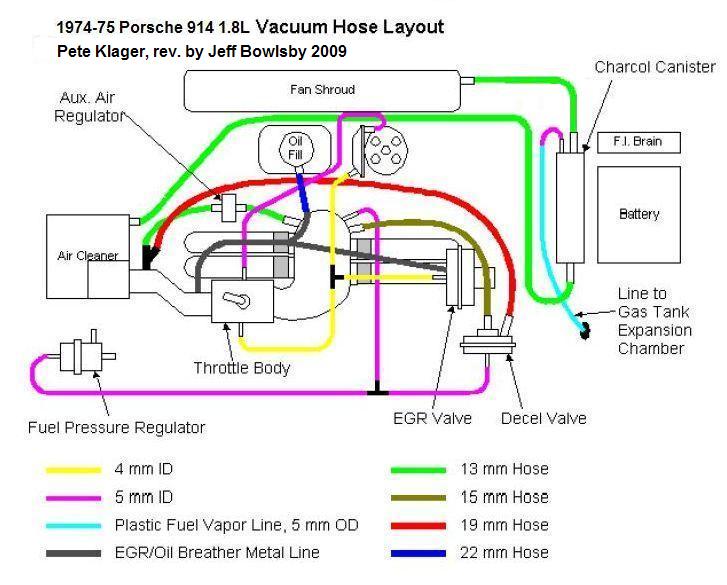
|
  |
Replies
| wonkipop |
 Feb 26 2025, 03:52 PM Feb 26 2025, 03:52 PM
Post
#2
|
|
914 Guru      Group: Members Posts: 5,188 Joined: 6-May 20 From: north antarctica Member No.: 24,231 Region Association: NineFourteenerVille 
|
for your interest @L-Jet914 .
here is an image of an intact unmeddled with 75 californian L jet with its EGR still connected and operational. (this was a very sound car that sold at sotherbys years back for a record price, totally unmeddled with). you can see how the EGR was connected to the T/B. there was no T back to the dizzy advance can as that diagram you post for a 75 cali shows. 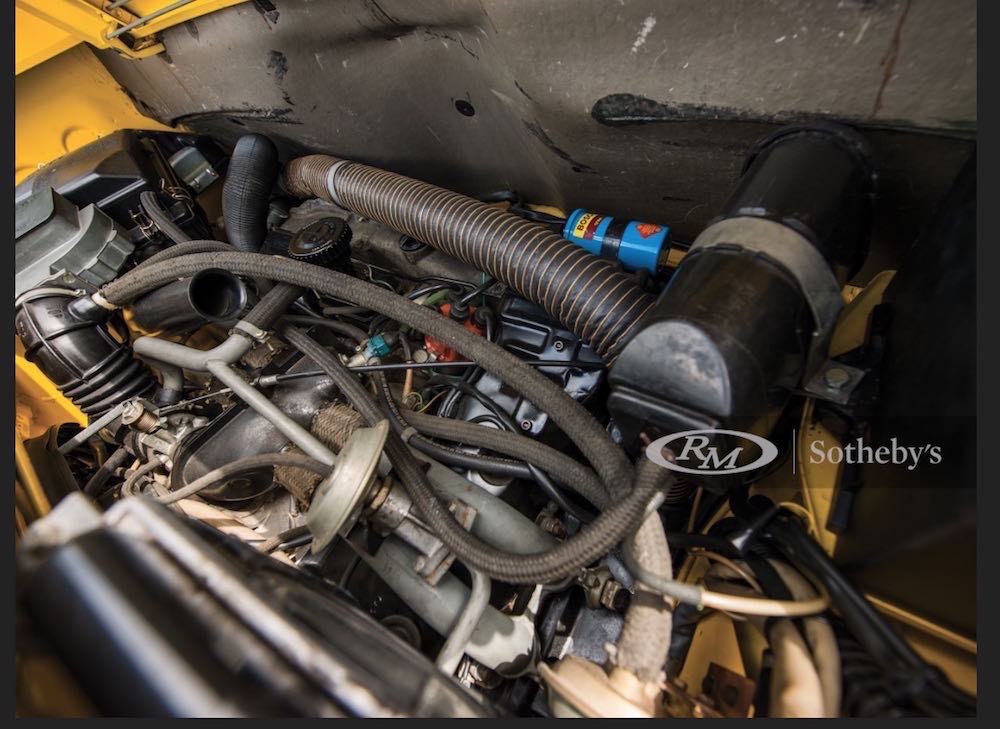 not that you have a 75. but it was basically like a 74 49 state in that it ran the engine cooler through the EGR at cruise even though the dizzy did not use an activated vac advance. it did this by virtue of the exhaust gases which lowered cylinder head temps with those exhaust gases despite the lack of vac advance and oddly also provided a tiny little bit of extra fuel economy. it ran slightly cleaner in terms of emissions of course with an EGR (still lowered NOX but also cleaned up unburnt hc and CO). but an EGR costs more money with its elaborate exhaust plumbing when compared to just a bit of vacuum hose like the 74 49 state had with its simple vac advance. and of course 74 49 was dirtier (it only lowered NOX at idle). its the 74 california and 75 49 states that really are a bit blunt with their vac advance disconnected and no other equipment to compensate that is the most compromised set up. sure they are cleaner in terms of NOX but the engines run hotter at steady highway cruise. which in the end must shorten engine life amongst other things. the moral is - a lot of the hose diagrams for the L jet from 20 years back are incorrect. the engines people were looking at to try and piece together the hose diagrams had already been meddled with and the original configurations not properly understood in terms of what was being done to meet emissions. if anything people were tearing emissions gear off engines without even properly understanding that in most cases they were not strangling the engines - at least in the case of VW EFI engines. the emissions gear does not rob horsepower in these engines. it was the lowered compression ratio for lower octane unleaded fuel that lead to the power level drops. also the other factor leading to all the somewhat incorrect older hose diagrams is there simply is no authorative hose diagrams for the L jets in the factory manuals. narthing. there may have been hose diagrams somewhere in tech literature that dealers had but if there was i have never come across it. |
Posts in this topic
 L-Jet914 vacuum hose routing question Feb 25 2025, 11:35 PM
L-Jet914 vacuum hose routing question Feb 25 2025, 11:35 PM
 wonkipop the authorative hose diagrams are here mate. bott... Feb 26 2025, 04:37 AM
wonkipop the authorative hose diagrams are here mate. bott... Feb 26 2025, 04:37 AM

 L-Jet914
the authorative hose diagrams are here mate. bot... Feb 27 2025, 10:21 PM
L-Jet914
the authorative hose diagrams are here mate. bot... Feb 27 2025, 10:21 PM
 JeffBowlsby Michael is the L-Jet MAN. That diagram on my site... Feb 26 2025, 09:09 AM
JeffBowlsby Michael is the L-Jet MAN. That diagram on my site... Feb 26 2025, 09:09 AM

 StarBear
Michael is the L-Jet MAN. That diagram on my sit... Feb 26 2025, 02:04 PM
StarBear
Michael is the L-Jet MAN. That diagram on my sit... Feb 26 2025, 02:04 PM

 wonkipop
Michael is the L-Jet MAN. That diagram on my si... Feb 26 2025, 02:39 PM
wonkipop
Michael is the L-Jet MAN. That diagram on my si... Feb 26 2025, 02:39 PM
 wonkipop @L-Jet914
i looked up the PET i have on file and... Feb 26 2025, 02:12 PM
wonkipop @L-Jet914
i looked up the PET i have on file and... Feb 26 2025, 02:12 PM
 wonkipop @L-Jet914
if you think i have mixed up the let... Feb 26 2025, 02:29 PM
wonkipop @L-Jet914
if you think i have mixed up the let... Feb 26 2025, 02:29 PM
 Fazasport I have a 1976 914 2.0 with D-Jet and no modificati... Feb 27 2025, 06:17 AM
Fazasport I have a 1976 914 2.0 with D-Jet and no modificati... Feb 27 2025, 06:17 AM

 wonkipop
I have a 1976 914 2.0 with D-Jet and no modificat... Feb 27 2025, 06:21 PM
wonkipop
I have a 1976 914 2.0 with D-Jet and no modificat... Feb 27 2025, 06:21 PM
 wonkipop @L-Jet914
david - that throttle body looks ident... Feb 28 2025, 10:57 AM
wonkipop @L-Jet914
david - that throttle body looks ident... Feb 28 2025, 10:57 AM

 L-Jet914
[b]@[url=http://www.914world.com/bbs2/index.php?s... Feb 28 2025, 07:57 PM
L-Jet914
[b]@[url=http://www.914world.com/bbs2/index.php?s... Feb 28 2025, 07:57 PM
 Rob-O Beyond all the hooking up of vacuum lines, the cha... Mar 3 2025, 07:35 AM
Rob-O Beyond all the hooking up of vacuum lines, the cha... Mar 3 2025, 07:35 AM

 wonkipop
Beyond all the hooking up of vacuum lines, the ch... Mar 3 2025, 05:53 PM
wonkipop
Beyond all the hooking up of vacuum lines, the ch... Mar 3 2025, 05:53 PM
 L-Jet914 Sorry for opening up a can of worms haha. When I r... Mar 4 2025, 12:35 AM
L-Jet914 Sorry for opening up a can of worms haha. When I r... Mar 4 2025, 12:35 AM

 emerygt350
Sorry for opening up a can of worms haha. When I ... Mar 4 2025, 08:39 AM
emerygt350
Sorry for opening up a can of worms haha. When I ... Mar 4 2025, 08:39 AM

 L-Jet914
Sorry for opening up a can of worms haha. When I... Mar 4 2025, 04:39 PM
L-Jet914
Sorry for opening up a can of worms haha. When I... Mar 4 2025, 04:39 PM

 wonkipop
Sorry for opening up a can of worms haha. When I... Mar 5 2025, 04:34 AM
wonkipop
Sorry for opening up a can of worms haha. When I... Mar 5 2025, 04:34 AM

 L-Jet914
Sorry for opening up a can of worms haha. When I... Mar 9 2025, 11:16 PM
L-Jet914
Sorry for opening up a can of worms haha. When I... Mar 9 2025, 11:16 PM
 emerygt350 Maybe my next CAD project. Mar 4 2025, 05:47 PM
emerygt350 Maybe my next CAD project. Mar 4 2025, 05:47 PM

 L-Jet914
Maybe my next CAD project.
Oooo. That would be a... Mar 4 2025, 05:54 PM
L-Jet914
Maybe my next CAD project.
Oooo. That would be a... Mar 4 2025, 05:54 PM
 emerygt350 I think I might have to try this project. Mar 4 2025, 07:25 PM
emerygt350 I think I might have to try this project. Mar 4 2025, 07:25 PM
 emerygt350 Yes, there is definitely that "driving a lazy... Mar 5 2025, 05:25 AM
emerygt350 Yes, there is definitely that "driving a lazy... Mar 5 2025, 05:25 AM  |
1 User(s) are reading this topic (1 Guests and 0 Anonymous Users)
0 Members:

|
Lo-Fi Version | Time is now: 1st November 2025 - 01:11 AM |
Invision Power Board
v9.1.4 © 2025 IPS, Inc.







